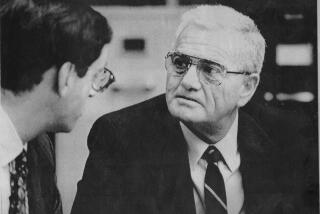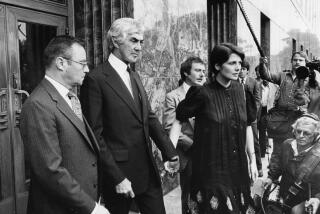DNA Proves What Man Long Insisted
CLEVELAND — Anthony Michael Green was convicted in 1988 of a horrible crime: raping and robbing a dying cancer patient. He was sentenced to 10 to 25 years in Ohio’s Grafton Correctional Institution.
But he steadfastly maintained his innocence. He refused to enroll in a program for sex offenders, even though he knew it might improve his chances for parole. When he came before the parole board in 2000 after serving 12 years of his sentence, he told them: “You might as well give me the other 12 years now, because I’m not admitting nothing.”
The parole board told him to come back in 30 months.
As it turns out, he was innocent.
DNA tests confirmed it last fall, and he was released. But it had taken 13 years, the help of a postal worker whom he’d never met and a group of lawyers from New York City to win his release.
Sitting here with his family recently, in the only home he’s ever known except a prison, the 36-year-old Green folded his hands and said, softly but determinedly: “An apology. That’s what I want.”
When Cuyahoga County Common Pleas Judge Anthony O. Calabrese vacated his sentence in October, Green became the 94th in a parade of convicted people freed in the U.S. through DNA testing.
That number hit 100 last month with the release of Larry Mayes, 52, from an Indiana prison after 21 years served for a rape he didn’t commit. Some of the cases have led to a dramatic change in the criminal justice system and given new fuel to the anti-death penalty movement. Illinois Gov. George Ryan, for instance, placed a moratorium on executions last year after several death row inmates in that state had their wrongful convictions overturned.
In the Green case, the nightmare began just after 10 p.m. on May 29, 1988. Someone knocked on an apartment door at the Cleveland Clinic Inn, where patients stay while being treated at the highly regarded hospital.
A 30-year-old nurse from West Virginia, a divorced mother of one who was dying of liver cancer, answered. A hand shot inside and tightened around her throat. Another came up with a knife.
The assailant was about 23 years old, she guessed later, 5 feet, 8 inches, 165 pounds. He was black, with a pockmarked face.
He took $42. Then he raped her.
Green said he was drinking with friends that night and had passed out on his girlfriend’s porch.
Green had just been fired from his job working as a dishwasher and then a maintenance man at the inn. Detectives knew he was familiar with the building’s layout and security.
In addition, a clinic security guard thought Green matched the description of the rapist. He was the same height, weight and race as the man described by the patient.
He also had a record: a misdemeanor conviction for domestic violence, from a scuffle with his girlfriend. He had been sentenced to a year of probation. “I was no mama’s boy,” Green would later say.
Two days after the rape, detectives showed the victim five photographs; one was of Green, taken from his clinic ID card. She could not identify any of the men as her attacker. A few days after that, police showed her five more photos, only one of which was a repeat: Green’s. “That’s him,” she said.
Misleading Testimony
Word spread through his tough Wade Park neighborhood, where junkies hang out by the corner store and churches cover their windows with plywood and bars. And when Green heard it, he went downtown to clear things up, offering a blood sample, hair samples, an alibi and the names of friends who could corroborate at least some of his story.
Police took the samples. Then they read him his rights. At his trial, the victim took the stand. “That man . . . grabbed me around the throat and put a knife in my face,” she said, pointing to Green.
The prosecution had a single piece of physical evidence: a soiled washcloth left behind by the rapist.
DNA testing was in its infancy in 1988. Indeed, many Americans first learned of its potential forensic value that same year, when three Hells Angels, also from Cleveland, were convicted of murder almost entirely on DNA evidence.
But in Green’s case, a Cleveland police criminalist performed a much more common series of tests on the cloth to determine the blood type of the rapist, whether he secreted a certain antigen and other biological specifics.
The criminalist, Joseph Serowick, told the jury that just 14% of black men could have produced the kind of semen on the cloth. The truth, all sides now agree, is that about 78% could have produced it.
Serowick also testified that the genetic markers on the washcloth had been produced by just one person. In fact, it may have contained fluids from both the attacker and the victim, and all the genetic traits in the sample that Serowick said pointed to Green could have been produced by the woman.
Serowick “either knew or should have known” that his report and testimony were flawed, wrote Edward T. Blake, a leading expert on forensic DNA, who helped conduct the tests that freed Green. “This entire line of proof misled the jury.”
Serowick declined to comment for this report.
Tim McGinty, the lead prosecutor in the case and now a county judge, built his closing argument around the flawed serology and the victim’s identification. McGinty said recently that he had requested a copy of the report but had not yet received one and could not comment about it.
When the guilty verdict was read, Green called to the jury: “I didn’t do this!”
As his appeals were denied, Green earned his high school diploma. He became a certified motorcycle mechanic and CPR instructor, and began learning Braille and translating social studies texts and Bibles for the blind.
By 1997, nine years after his conviction, Green decided to try to free himself. He began by quizzing an inmate who knew about a program that had helped free the wrongly convicted through DNA testing.
Founded in 1992 by attorneys Barry Scheck and Peter Neufeld, the Innocence Project at New York’s Cardozo School of Law has helped with more than half of the cases overturned through DNA evidence. The work of the project’s law students and handful of attorneys has prompted the launch of about 20 similar programs in the last few years.
Green began writing letters to the project. He also sought help from a very unlikely source, Robert Mandell, the stepfather whom he had never met.
Mandell, a gregarious man with a biting wit and big handshake, was an odd choice for at least one reason: He was entirely convinced of his stepson’s guilt.
A now-retired maintenance supervisor at the main post office in Akron, Ohio, Mandell had met Green’s mother in 1994 and married her in 1996. Annie Mandell had tried to help her son over the years but couldn’t convince attorneys that Green’s was a cause worth pursuing.
“I told her, ‘Honey, all mothers think their children are innocent,’ ” Mandell said.
Stepfather Comes to Aid
But Green persisted, viewing his stepfather as a potential ally. Mandell knew a bit about the law, and to Green, he had the most important credential of all: He was on the outside.
Green begged Mandell to at least read the trial transcript. His stepfather finally agreed, mostly out of a sense of duty to Green’s mother.
“The testimony runs to 500 pages,” Mandell said. “I got about halfway through and I said: ‘Hey, he didn’t do it.’ ”
There were problems with the description of the assailant: The victim had said his face was pockmarked by acne, but Green’s is smooth. Also, Green’s alibi witnesses never testified. Most were young men with outstanding warrants who were afraid to show up in court.
By late 1997, Mandell, who still had not met his stepson, began spending nearly all his free time playing sleuth.
“That case had so many holes in it, it was a shame,” he said. Exploiting them, however, would be an excruciatingly slow process.
Mandell studied Green’s failed appeals. He tracked down police files, detectives’ notes, the photo lineups. Students and attorneys from the Innocence Project offered legal advice. They also told him he had to find that washcloth. Without it, there was no DNA to test.
After months of pressuring the police to find it, Mandell learned that it was still sitting in a dank evidence storage room in the basement of the Cuyahoga County Courthouse.
It took the Innocence Project a year just to review and accept his case. Months more were spent filing requests to study the washcloth, months more waiting for replies.
Last spring, authorities finally gave the go-ahead to send DNA samples to the lab. Mandell paid about $6,700 for the tests with money from his pension--money, he said recently, smiling at Green, he expects to see again.
In August, the results came back.
“The tests were so clear-cut that once you saw Michael’s DNA and the perpetrator’s DNA, the perpetrator might as well have been from another planet,” said Elizabeth Kelley, one of Green’s attorneys.
On Oct. 9, after prosecutors tested Green once more to make certain the exonerating DNA was really his, the doors opened at the Cuyahoga County Jail and Green walked through them and into the arms of his stepfather.
Over the next week, he took out the trash, went to his stepfather’s retirement party and called a girl he’d had a crush on for 25 years; she said yes when he asked her out. He began planning his new life, trying to decide whether to set up a Braille translation business or become a corrections officer, and attempting to clear his name from state records that continued to list him as a convicted felon.
There was one more thing to do, however, to make it official.
A week later, he returned to the courthouse for Judge Calabrese to vacate his sentence.
“How do you restore those years that you spent in prison?” Calabrese said. “Maybe only God can answer that question.”
*
Times researcher John Beckham in Chicago contributed to this report.
More to Read
Sign up for Essential California
The most important California stories and recommendations in your inbox every morning.
You may occasionally receive promotional content from the Los Angeles Times.










